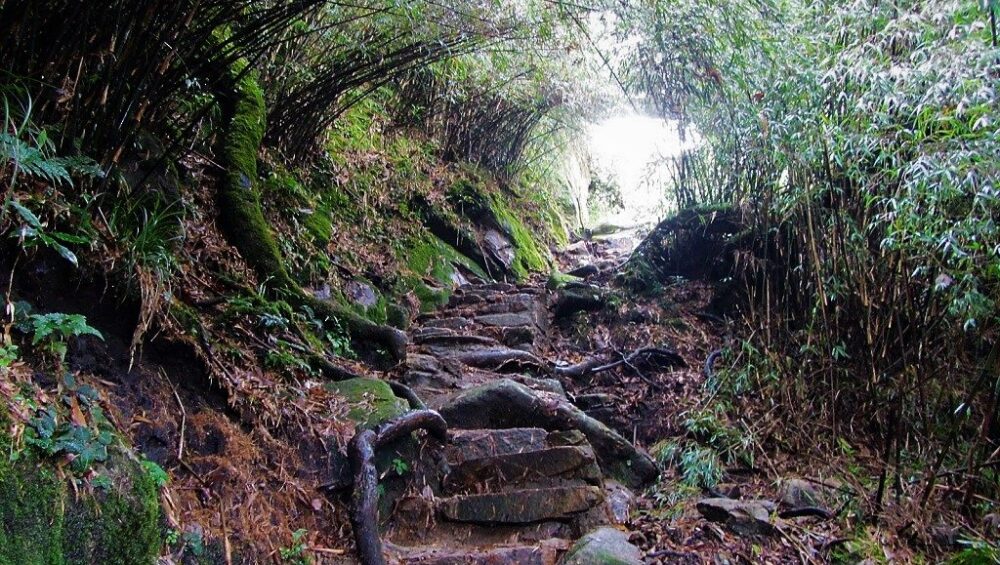Fansipan, standing at 3,143 meters above sea level, is not only the highest mountain in Vietnam but also a dream destination for adventure seekers and trekking enthusiasts. Nicknamed “The Roof of Indochina,” the summit is located in Lao Cai Province, within the majestic Hoang Lien Son mountain range, about 9 km from the town of Sapa.
The trekking journey to Fansipan’s summit is more than just a mountain climb—it’s a transformative experience that pushes your physical and mental limits, offering a chance to reconnect with yourself, marvel at the natural beauty of northwest Vietnam, and discover the vibrant cultures of the region’s ethnic minorities.
🌿 NATURAL BEAUTY & BIODIVERSITY
Along the trek, you’ll pass through diverse landscapes and ecosystems. From dense tropical forests at lower altitudes to lush moss-covered temperate woodlands at mid-levels, and sparse, icy vegetation near the peak—each stage paints a vivid picture of nature’s variety.
The Fansipan area is home to over 2,000 species of plants and many rare animals, including the snub-nosed monkey, Asiatic black bear, goral, and several endemic bird species.
🏕️ WHY CONQUER FANSIPAN?
- Experience the awe of standing on the highest point in Indochina
- Witness breathtaking scenery: seas of clouds, bamboo forests, blooming rhododendrons
- Camp in the wilderness, greet the sunrise or sunset in magical surroundings
- Immerse yourself in the unique cultures of the H’Mong, Dao, and Giay people
- Bond with fellow trekkers over shared challenges and triumphs
🧭 TREKKING TOUR OPTIONS FOR EVERYONE
Depending on your fitness level, experience, and preferences, here are the main Fansipan trekking tours:
1-Day Trek (for experienced hikers)
- Duration: Around 10–12 hours round-trip
- Route: Tram Ton – Fansipan Summit – Tram Ton
- Pros: Fast, time-efficient
- Note: Requires high endurance and trekking skills
2–3 Day Trek (ideal for beginners)
- Day 1: Sapa – Tram Ton – Camp 1 (overnight camping)
- Day 2: Climb to summit and return
- Pros: Slower pace, time to rest and enjoy the scenery
Cultural Trek (3–5 days)
- Trek combined with village visits (e.g., Ta Van, Muong Hoa Valley)
- Experience local homestays, cooking classes, highland markets
- Best for those who want to deeply explore local culture
🍁 BEST TIME TO TREK FANSIPAN
Spring (Feb – Apr): Warm weather, blooming plum, peach, and rhododendron flowers
Autumn (Sep – Nov): Cool, dry air and clear skies for stunning photography
❗ Seasons to Avoid:
- Summer (Jun – Aug): Heavy rains, slippery trails, risk of landslides
- Winter (Dec – Jan): Very cold, possible snow, dry air increases health risks
🏋️ PREPARATION TIPS
Start physical training 4–8 weeks before the trek to avoid exhaustion:
- Jogging, cycling, stair climbing
- Practice hiking with a 5–7 kg backpack
Essential Gear:
- Non-slip hiking boots (preferably broken-in)
- Windbreaker, thermal layers, quick-dry pants
- Trekking backpack, walking stick, headlamp
- Sleeping bag, raincoat, sun hat
- Lightweight, high-energy foods (e.g., chocolate, nuts, candy)
- Water, purification tablets, first-aid kit, personal meds
🗺️ SUGGESTED ITINERARY – 2-DAY FANSIPAN TREK
Day 1:
- Morning: Travel from Sapa to Tram Ton, begin ascent
- Midday: Lunch break in the forest
- Afternoon: Reach Camp 1, set up tents, dinner, and overnight stay
Day 2:
- Early morning: Continue climb to Fansipan summit, catch sunrise
- Midday: Light meal and rest
- Afternoon: Descend back to Tram Ton, end of journey
📌 CONCLUSION
Trekking Fansipan is a challenging yet deeply rewarding adventure. It’s a place where you realize how small you are amidst towering mountains—and at the same time, where you discover your inner strength.
If you love nature and are looking for a memorable escape from the everyday grind, then conquering Fansipan is a milestone you won’t want to miss.




